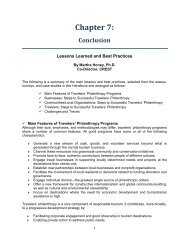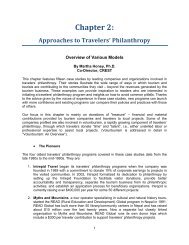Travelers' Philanthropy Handbook - Center for Responsible Travel
Travelers' Philanthropy Handbook - Center for Responsible Travel
Travelers' Philanthropy Handbook - Center for Responsible Travel
You also want an ePaper? Increase the reach of your titles
YUMPU automatically turns print PDFs into web optimized ePapers that Google loves.
. Some organizations and projects accept material donations and volunteers. Be sureto develop your own policy rather than waiting until the situation arises.c. All donations should be needs-driven, not donor-driven. In other words, determinewhat your community or local organization needs, then communicate and consultwith the tourism company with which you intend to partner.d. Ensure there is “local ownership” of the project and that there is a high level ofcommunity engagement in and local support.e. Care must be taken to avoid local dependence on tourists to bring hand-outs and to‘fix everything’ <strong>for</strong> the community or the project.2. Assess Your Organizational Capacity to Manage a <strong>Travel</strong>ers’ <strong>Philanthropy</strong>Programa. Train and dedicate staff to run the program.b. Negotiate terms and secure written agreements with travel companies who aresending visitors or funding.c. Develop a strategy and materials to in<strong>for</strong>m travel companies and travelers aboutyour activities.d. Administer contributions with transparency, oversight, and compliance with legal andfinancial regulations.e. Assist with an independent annual assessment and audits of donor-supportedprojects.f. Establish a system <strong>for</strong> reporting to donors (photos, website and written updates,audits, due diligence inspections by independent party, etc.).3. Carefully Weigh the Pros and Cons of Site Visitsa. Site visits have proven to be the most effective way of introducing visitors to yourproject or organization and generally increase the number and size of financialdonations.b. However, they take time and resources, and in some cases, are not appropriate.o Timing and frequency of site visits should be negotiated and pre-arranged toavoid disrupting the organization’s activities and allow <strong>for</strong> coordinated, wellstaffedpresentations.o Visits should not feel ‘voyeuristic’ or uncom<strong>for</strong>table <strong>for</strong> either visitors or locals.o Some projects are by their nature not appropriate <strong>for</strong> site visits: clinics dealingwith HIV/AIDS or other sensitive health issues, schools when classes areunderway.o Visits to child welfare projects must always be pre-arranged and haveappropriate oversight. Brief visits often encourage a culture of dependency andteach children that looking cute <strong>for</strong> <strong>for</strong>eigners brings gifts or money.o Extra sensitivity and planning are important when visiting projects in remote orethnic minority communities. Guides and tour leaders should prepare visitorsbe<strong>for</strong>ehand on what to expect and what is appropriate behavior.4. Develop a Fundraising Strategy to Ensure Your Engagement with <strong>Travel</strong>ers BringsBenefits to Your Organization.a. Unless a travel company is raising large sums <strong>for</strong> the organization, the companyshould cover the organization’s cost of hosting visits, including staff time, brochures,212















